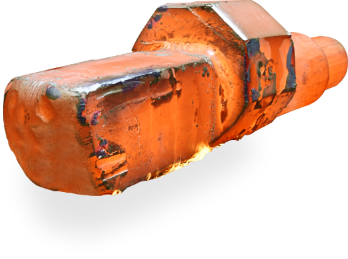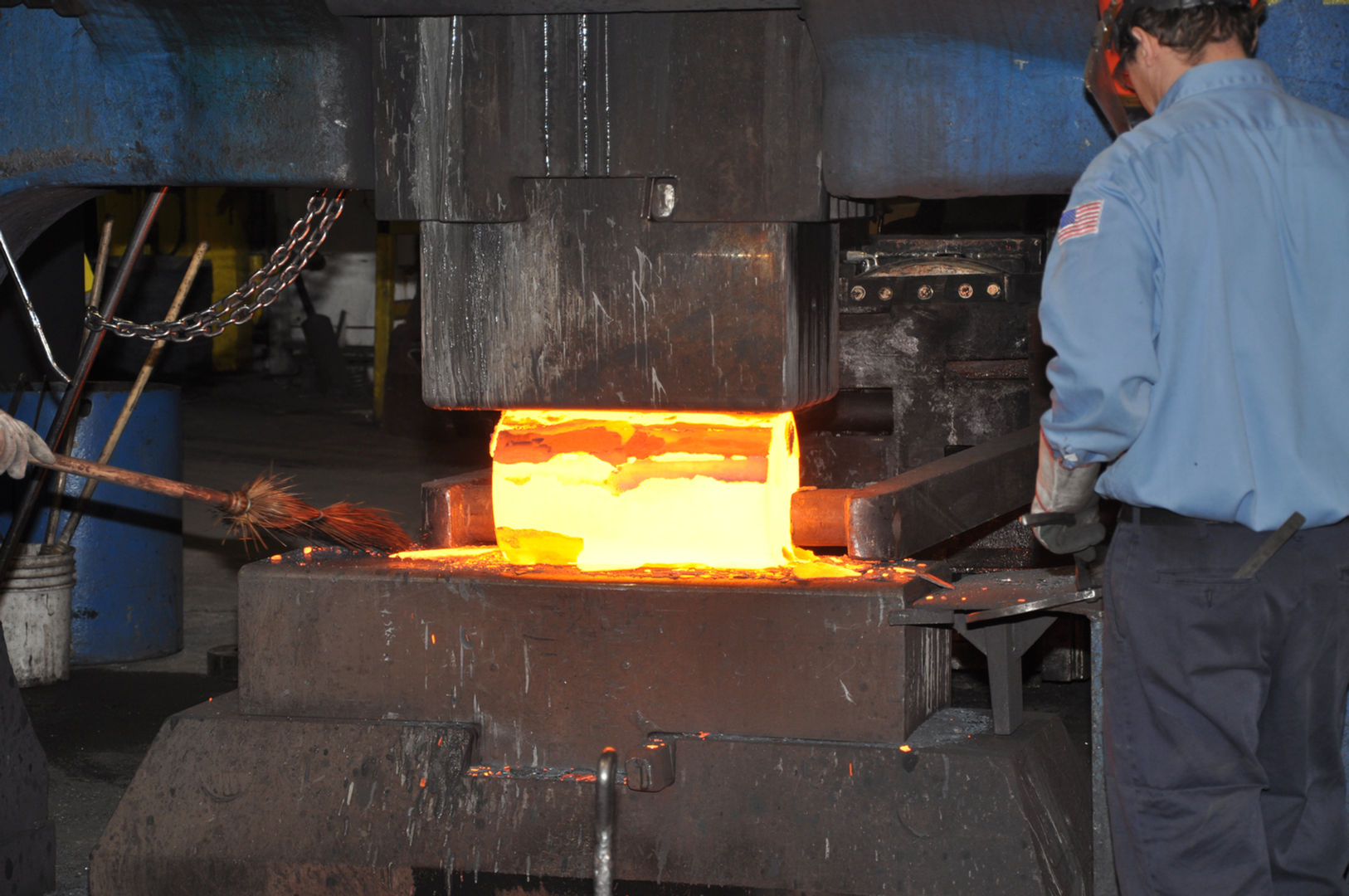
HUBS & TOOLED FORGINGS
.jpg)
Why Forged Hubs?
When purchasing hubs and spindles, product integrity is critical often making or breaking a part in the field. Machined castings or hot-rolled machined bars tend to have poor structural integrity or inclusions that lead to problems with cracking and part failure. As shown in the cases below, forging has proven to be a successful solution to these problems.
.jpg)
Why Forged Hubs?
When purchasing hubs and spindles, product integrity is critical often making or breaking a part in the field. Machined castings or hot-rolled machined bars tend to have poor structural integrity or inclusions that lead to problems with cracking and part failure. As shown in the cases below, forging has proven to be a successful solution to these problems.

Forged Hub Process Highlights
The thousands of in-stock tools at our Franklin Park hammer shop and press plants capabilities provide the ability for us to produce both simple and complex hubs as near-net shaped forgings. During the forging process, material fills the tool or tools and directional grain flow is produced, giving the hub improved strength, ductility and resistance to impact and fatigue.
Infinite Variety of Sizes
Sizes range from 3" to 144" in diameter. With no minimums for stocking grades, you can order single-piece or large quantities of products varying from a few pounds to 300,000 lbs., which we can achieve through the capabilities of our joint venture, North American Forgemasters, where we have the ability to create over-sized forgings.
Cost-Effective
Our practices reduce stock, improve mechanical capabilities and limit additional machining, making it ideal for prototypes and short-run requirements. Working with our technically trained sales staff, we are oftentimes able to provide a more cost-effective solution than a machined bar, weldments or closed die forgings, all while staying within your specific time constraints.
Forged Hub Process Highlights
The thousands of in-stock tools at our Franklin Park hammer shop and press plants capabilities provide the ability for us to produce both simple and complex hubs as near-net shaped forgings. During the forging process, material fills the tool or tools and directional grain flow is produced, giving the hub improved strength, ductility and resistance to impact and fatigue.
Infinite Variety of Sizes
Sizes range from 3" to 144" in diameter. With no minimums for stocking grades, you can order single-piece or large quantities of products varying from a few pounds to 300,000 lbs., which we can achieve through the capabilities of our joint venture, North American Forgemasters, where we have the ability to create over-sized forgings.
Cost-Effective
Our practices reduce stock, improve mechanical capabilities and limit additional machining, making it ideal for prototypes and short-run requirements. Working with our technically trained sales staff, we are oftentimes able to provide a more cost-effective solution than a machined bar, weldments or closed die forgings, all while staying within your specific time constraints.
Product/application
Hub for air compressor
Material
Stainless Steel
Previous processing problems
The previous process involved casting, followed by intricate machining.
-
Critical surface quality requirements were not met with the casting.
-
After extensive machining, part rejections arose due to porosity, extending lead times and incurring additional rework or replacement costs.
Forging as the solution
Today the part is made as a forging, providing outstanding strength, soundness and structural integrity properties.
-
Surface quality standards are met through combining the forging process with controlled material selection.

Product/application
Coupling hub for high-pressure cylinder
Product/
application
Alloy Steel
Material
4-1/4" O.D. X 4-1/4" Long,
Stepped Down to 1-3/4" O.D.
X 5" Long
PREVIOUS PROCESSING PROBLEMS
The former process involved sawing and machining a hot-rolled bar to shape.
-
The longitudinal grain flow caused cracking, which led to field failures.
-
Abuse in the field was causing more wear than expected, resulting in breakage and the need for stronger parts.
Forging as the solution
Today, a customized forging process provided the solution.
-
Forging produces a special isotropic grain flow, which is required to meet the design specifications.
-
Controlling the grain flow has increased part strength and minimized field failures.

Product/application
Gearbox Pinion
Material
Alloy Steel
Previous processing problems
The previous process involved casting, followed by intricate machining.
-
Critical surface quality requirements were not met with the casting.
-
After extensive machining, part rejections arose due to porosity, extending lead times and incurring additional rework or replacement costs.

Forging as the solution
Today the part is made as a forging, providing outstanding strength, soundness and structural integrity properties.
-
Surface quality standards are met through combining the forging process with controlled material selection.


Scot Forge Difference
At Scot Forge, we know the importance of getting your parts on-time, as expected. However, for customers new to procuring forgings, ordering a forging that will meet all specifications for end-use applications may be a challenge, which is why finding a trusted supplier and partner is essential. Our employee-owners are here to ensure your project stays on track with our forgings by offering:
We offer many size forgings in both standard and unique geometries to meet your needs.
Pro Tip - Did you know near-net shapes can save you time and money? Oftentimes, a customer calls to order a disc, which they will later machine down to a more shaped part. By working with our technically trained sales team, you can get your finished product shape as close as possible to optimize your production process.
Product/application
Hub for air compressor
Material
Stainless Steel
Previous processing problems
The previous process involved casting, followed by intricate machining.
-
Critical surface quality requirements were not met with the casting.
-
After extensive machining, part rejections arose due to porosity, extending lead times and incurring additional rework or replacement costs.
Forging as the solution
Today the part is made as a forging, providing outstanding strength, soundness and structural integrity properties.
-
Surface quality standards are met through combining the forging process with controlled material selection.

Product/application
Coupling hub for high-pressure cylinder
Material
Alloy Steel
Hub size
4-1/4" O.D. X 4-1/4" Long,
Stepped Down to 1-3/4" O.D.
X 5" Long
PREVIOUS PROCESSING PROBLEMS
The former process involved sawing and machining a hot-rolled bar to shape.
-
The longitudinal grain flow caused cracking, which led to field failures.
-
Abuse in the field was causing more wear than expected, resulting in breakage and the need for stronger parts.
Forging as the solution
Today, a customized forging process provided the solution.
-
Forging produces a special isotropic grain flow, which is required to meet the design specifications.
-
Controlling the grain flow has increased part strength and minimized field failures.

Product/application
Gearbox Pinion
Material
Alloy Steel
Previous processing problems
Previously, the pinion was manufactured from a hot-rolled bar, machined to size.
-
Critical surface quality requirements were not met with the casting.
-
After extensive machining, part rejections arose due to porosity, extending lead times and incurring additional rework or replacement costs.

Forging as the solution
Today the part is made as a forging, providing outstanding strength, soundness and structural integrity properties.
-
Surface quality standards are met through combining the forging process with controlled material selection.












